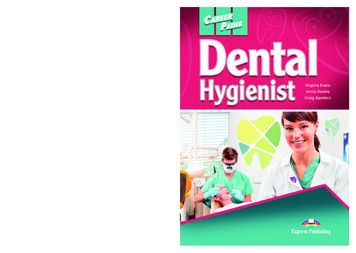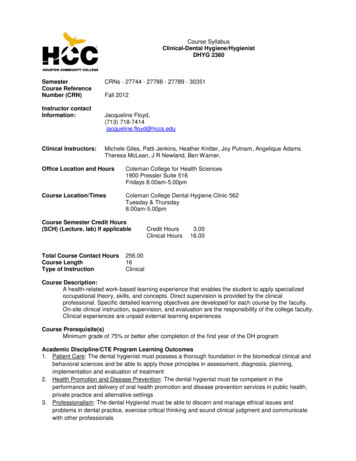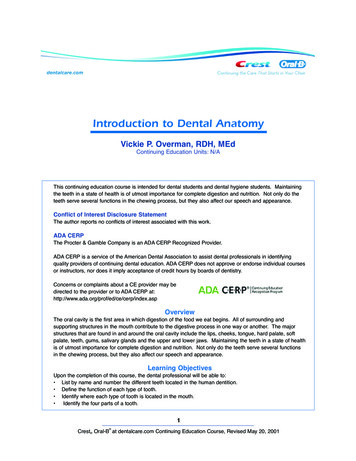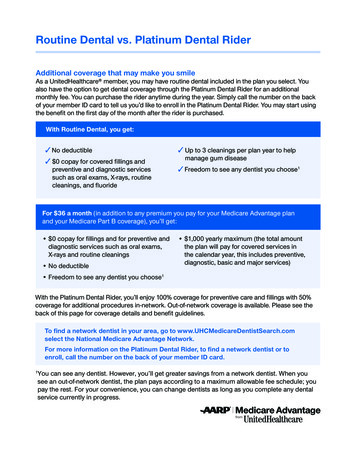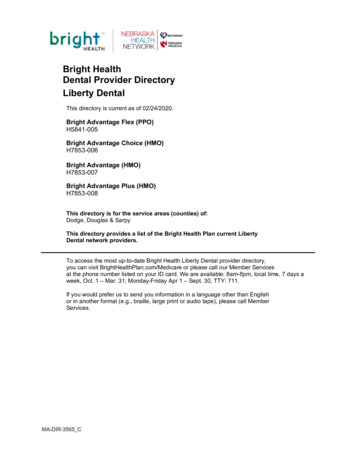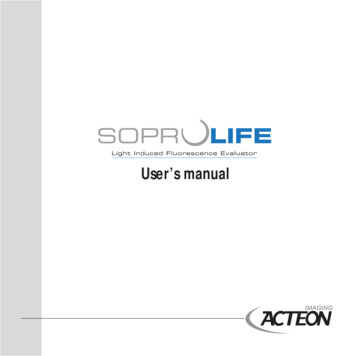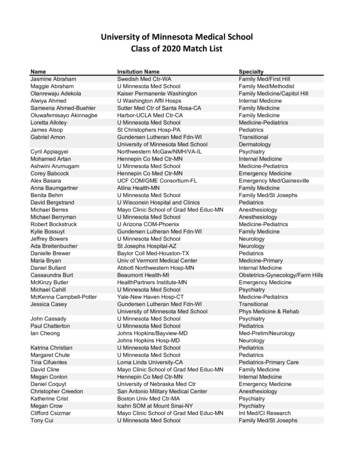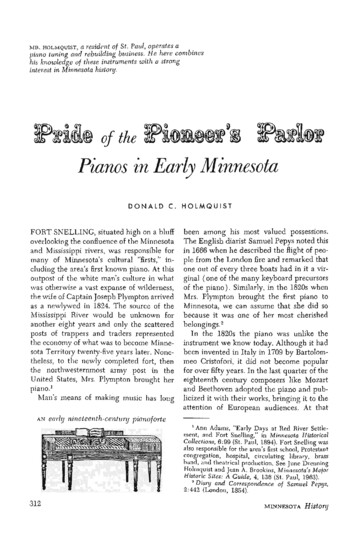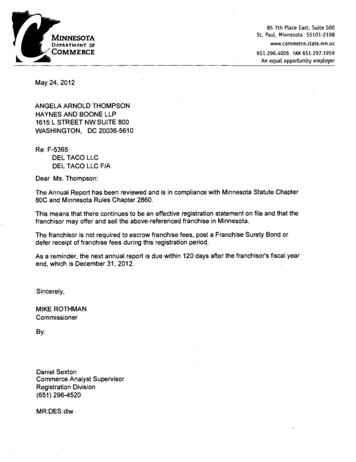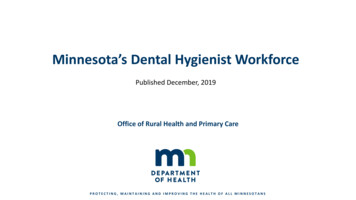
Transcription
Minnesota’s Dental Hygienist WorkforcePublished December, 2019Office of Rural Health and Primary CarePROTECTING, MAINTAINING AND IMPROVING THE HEALTH OF ALL MINNESOTANS
Contents and Quick LinksIntroductionSummary of FindingsDemographicsDemographics: Sex and AgeDemographics: Race and EthnicityDemographics: Languages Spoken in PracticeEducationGeographic DistributionEmploymentMethodology and NotesEducation: Educational AttainmentEducation: MN Graduates by InstitutionEmployment: Employment & Hours WorkedEmployment: Future Plans1/23/2020Dental Hygienists at Work: Work SettingsDental Hygienists at Work: Collaborative AgreementsDental Hygienists at Work: Restorative ProceduresDental Hygienists at Work: EHRs and TelemedicineDental Hygienists at Work: TeamworkDental Hygienists at Work: Cultural CompetenceDental Hygienists at Work: Career SatisfactionGeographic Distribution: Two Ways to Present GeographyGeographic Distribution: by Planning AreaGeographic Distribution: by RuralityMethodologyNotesPROTECTING, MAINTAINING AND IMPROVING THE HEALTH OF ALL MINNESOTANS2
Summary of Findings1/23/2020 As of August 2019, there were 5,683 actively licensed dental hygienists in Minnesota, the majority of whom work in the 7-county metro area (see slide 19). The youngest cohort of dental hygienists entering the labor market is just over one quarter of the current workforce. New dental hygienists entering theworkforce outnumber those intending to leave the workforce in the next five years. The majority of dental hygienists planning to leave the profession in fiveyears are retiring (see slides 4 and 8). Ninety-two percent of Minnesota’s dental hygienists are white, and roughly 73 percent speak only English in their practice without the help of an interpreter(see slides 5, and 6). Ninety-one percent of dental hygienists are working in a position related to their license. The majority of them work full-time (see slide 7). Sixty-five percent of dental hygienists plan to work in the field for more than 10 years (see slide 8). Collaborative practice agreements allow dental hygienists to work in community settings without the presence of a dentist on site. Only about 11 percent ofdental hygienists report having collaborative agreements with their dentist, and nearly 72 percent never use them. Similarly, only four percent of dentalhygienists have a restorative procedures credentials, but 73 percent report not performing the functions authorized. (see slides 12 and 13). Similar to many healthcare professions, most dental hygienists are satisfied with their work. Dental hygienists report higher levels of satisfaction with theircareer overall than they do with their work specifically in the last 12 months (see slide 17). Like many other health care provider types, the majority of dental hygienists practice in urban areas. Assuming the same share of people need dental servicesin urban and rural areas, rurally-based dental hygienists are facing a patient load almost two times greater than their urban counterparts (see slide 20).PROTECTING, MAINTAINING AND IMPROVING THE HEALTH OF ALL MINNESOTANS3
Demographics: Age and SexAge of Minnesota Dental Hygienists65 and older55 to 6421%45 to 5420%35 to 4435 and younger 5%27%27%Minnesota’s dental hygienist workforce has relatively similar shares of providers in the two youngest age cohorts, which account for nearly 54 percent of the workforce.The smallest share–five percent–of actively licensed dental hygienists are 65 and older and at or nearing retirement age. Currently, the median age of dental hygienists is43.Additional information not shown above: Roughly 98 percent of dental hygienists in Minnesota reported they were female. However, younger dental hygienists include more males than their older counterparts. Forexample, 31 percent of dental hygienists under 35 reported they were male compared to 10 percent of dental hygienists age 55 to 64.Source: Minnesota Board of Dentistry, August 2019. Analysis done by MDH. Percentages are based on 5,683 actively licensed dental hygienists who provided valid birth dates to the licensing board.4
Demographics: Race and EthnicityRace of Minnesota Dental HygienistsWhite 92.0%Asian3.2%Multiple c/Latinx0.5%American Indian0.2%Other Race0.6%Typical of racial patterns among health care professionals, the majority (92.0 percent) of dental hygienists indicated they were white, with the second highest share(3.2 percent) indicating they were Asian.Source: MDH Dental Hygienist Questionnaire, 2016-2017. Respondents could select as many races as applicable. The chart is based on 2,679 valid survey responses.5
Demographics: Languages Spoken in PracticeLanguages Spoken by Minnesota Dental Hygienists in their Practices91.1%3.1%English only oximately 73 percent of dental hygienists spoke only English in their practice. The second most commonly spoken language was Spanish. Very small shares ofdental hygienists spoke other languages such as Hmong, Russian, or Somali with their patients. Just over four percent of dental hygienists reported speakinglanguages other than those shown above in practice. Common “other” languages mentioned included American Sign Language, Vietnamese, Amharic, and French.Source: MDH Dental Hygienist Questionnaire, 2016-2017. Respondents could select as many languages as applicable, but were instructed not to include languages spoken only through an interpreter. The chart isbased on 3,012 valid survey responses.6
Education: Educational Attainment“What is the highest degree you have completed?”Degree TypeDiploma or Certificate (no college)Some College, No DegreeAssociate’s DegreeCertificate or Other Credential (post-Associate’s)Bachelor’s DegreeCertificate or Other Credential (post-Bachelor’s)Master’s DegreeCertificate or Other Credential (post-Master’s)Doctorate or Professional Degree Hygienists with proximately half of the dental hygienist workforce (54 percent) earned an associate’s degree as their highest degree. The second most popular is a bachelor’s degree,earned by about 31 percent of the workforce.Source: MDH Dental Hygienist Workforce Questionnaire, 2016-2017.7
Education: MN Graduates by InstitutionAll Degrees Awarded from Minnesota Dental Hygiene Programs, by YearRegionTwin CitiesNortheastNorthwestSoutheastCentralMinnesota InstitutionArgosy UniversityUniversity of Minnesota – Twin CitiesMetropolitan State UniversityNormandale Community CollegeCentury CollegeHerzing UniversityLake Superior CollegeMinnesota State Community and Technical CollegeMinnesota State University – MankatoRochester Community and Technical CollegeSt. Cloud Technical and Community nnesota State University-Mankato produced the most dental hygiene graduates from 2015-2017. Argosy University (closed in 2019) and the University of MinnesotaTwin Cities also had a large number of graduates. From 2015-2017, the graduation rate was relatively steady at each institution. Herzing University is greatly different inthis regard, as the number of graduates dropped dramatically over three years.Source: National Center of Education Statistics, Integrated Postsecondary Educational Data System (IPEDS).8
Employment: Employment & Hours WorkedHours Worked in a Typical Week54.0%27.7%6.1%10 or less 10.2%11-2021-3031-401.6%0.2%0.2%41-5051-6061 or moreThe median work week for dental hygienists was 32 hours, with the majority (54 percent) of dental hygienists working between 31 and 40 hours per week. Sixtythree percent of dental hygienists consider their work schedule to be full-time.Additional information not shown above: An estimated 91 percent of Minnesota dentists reported on the MDH questionnaire that they were “working in a paid or unpaid position related to [their] license.”Of those not working in a position related to their license, about half (approximately 52 percent) were not seeking a position using their license.Source: MDH Dental Hygienist Workforce Questionnaire, 2016-2017. Percentages are based on 2,632 valid responses.9
Employment: Future Plans“How long do you plan to continue practicing as a Dental Hygienist in Minnesota?”5 years or less14%6 to 10 yearsMore than 10 years 21%65%Approximately 14 percent of all actively practicing dental hygienists indicated that they plan to leave the field within five years. The majority – 65 percent – plan topractice for more than 10 years.Additional information not shown above: Among the 14 percent of dental hygienists planning to stop working within the next 5 years, most said they planned to retire (74 percent). The remaining dentalhygienists said they planned to leave to pursue a different career (8 percent); for family or other reasons (7 percent); because of burnout or dissatisfaction (5 percent) orfor some other reason (4 percent).Source: MDH Dental Hygienist Workforce Questionnaire, 2016-2017. Percentages are based on 2,634 valid responses.10
Dental Hygienists at Work: Work SettingsDental Hygienists’ Primary Work SettingsSettingClinic/Professional Office/Health Center/Ambulatory CareAcademic (Teaching/Research)Community/Faith-Based OrganizationPublic Health AgencyHospitalState, County, or City AgencyCorrectional FacilityInsurance/Benefits Management OrganizationLong-Term Care FacilityCommercial or Private Research LaboratoryOther Share of DentalHygienists Working inthis 5%The vast majority of dental hygienists (92.1 percent) work in a clinic, professional office, health center or in ambulatory/outpatient care setting.Source: MDH Dental Hygienist Workforce Questionnaire, 2016-2017. The survey includes questions on both the “primary” and “secondary” settings in which providers work. For the purposes of the analysis in thissection, we present data only on the setting Dentists reported as their “primary” setting. The chart above is based on 2,458 valid responses.11
Dental Hygienists at Work: Collaborative AgreementsDental Hygienists’ Utilization of Collaborative Agreements72%23%NeverOccasionally2%4%FrequentlyAll the Time A collaborative agreement is a signed document between a licensed dentist and a licensed dental hygienist that allows the dental hygienist to work in a nontraditional setting like schools or other community-based setting without the presence of a dentist on site. Providing oral health services in community settingsis one way to address access to care challenges. Only about 11 percent of dental hygienists have a collaborative agreement with a dentist (data not shown above). Of those who do have a collaborativeagreement in place, only about four percent report practicing under the agreement all the time while 72 percent never use it.Source: MDH Dentist Workforce Questionnaire, 2016-2017. Percentages are based on 2,130 valid responses.12
Dental Hygienists at Work: Restorative ProceduresHow Often Dental Hygienists Perform Restorative Procedures73%22%NeverOccasionally2%3%FrequentlyAll the Time The survey asked dental hygienists if they have a restorative procedures credential. This credential allows dental hygienists to perform “expanded functions” orprocedures beyond their typical scope of practice, freeing up the dentist to perform additional procedures. Examples of expanded functions include placing,contouring, and adjusting amalgam restorations, glass ionomers, class I and V supragingival composite restorations, adapting and cementing stainless steel crowns. Approximately four percent of dental hygienists report having the credential to perform restorative procedures (data not shown above). Among this group, threepercent perform these procedures all the time, while 73 percent report never doing them.Source: MDH Dentist Workforce Questionnaire, 2016-2017. Percentages are based on 5,683 valid responses.13
Dental Hygienists at Work: EHRs and TelemedicineDental Hygienists’ Use of Electronic Health Records and Telemedicine Equipment76%68%7%12%11%6%How often do you use electronic health records or similarpatient/client electronic records?NeverOccasionallyFrequentlyAll the time10%11%How often do you diagnose or consult with patients or clients inreal-time using dedicated telemedicine equipment? The MDH workforce survey includes questions on the use of technology in health care settings. The results show that three-fourths of dental hygienists useelectronic patient records “all the time.” Most dental hygienists report never using telemedicine equipment to diagnose or consult with patients. This indicates untapped capacity in the use oftelemedicine to deliver oral health services.Source: MDH Dental Hygienist Workforce Questionnaire, 2016-2017. Percentages are based on 2,494 valid responses.14
Dental Hygienists at Work: Teamwork“Which of the following work or educational experiences best prepared youto work in a multidisciplinary team when providing care?”Informal learning on-the-job40%Formal on-the-job training17%Continuing education/professional development12%Formal educational coursework or training17%Does not apply to my jobNone 9%5%Health care providers increasingly work in multidisciplinary teams, prompting educators and health policymakers to ask how best to train providers tocommunicate and coordinate across professions. MDH included a question on its survey to shed light on these questions. As shown above, over half of dentalhygienists reported that on the job training/learning best prepared them to work in multidisciplinary teams.Source: MDH Dental Hygienist Workforce Questionnaire, 2016-2017. Percentages are based on 2.644 valid responses.15
Dental Hygienists at Work: Cultural Competence“Which of the following work or educational experiences best prepared youto provide culturally competent care?”Informal learning on the job41%Formal educational coursework or training21%Continuing education/professional development16%Formal on-the-job training 12%Does not apply to my job5%None5%Stakeholders are increasingly concerned about the extent to which providers deliver care that is culturally sensitive to all communities. The MDH survey includes a question tounderstand which experiences best prepare health care providers to provide culturally competent care. As shown above, the largest share of dental hygienists (just over 40percent) report that they learn cultural competence best through informal, on-the-job learning followed by educational coursework (21 percent) and continuing education orprofessional development (16 percent).Source: MDH Dental Hygienist Workforce Questionnaire, 2016-2017. Percentages are based on 2,645 valid responses.16
Dental Hygienists at Work: Career SatisfactionHow satisfied have you been with your career .45.3%50.7%48.4%Very satisfied45.2%SatisfiedDissatisfiedVery dissatisfied4.5%1.8%In the last 12 months? 2.7%1.4%Overall?The survey included questions on career satisfaction in the past 12 months and overall. Dental hygienists reported being only slightly less satisfied with their career in the last12 months as compared to their career overall.Source: MDH Dental Hygienist Workforce Questionnaire, 2016-2017. Percentages are based on 2,416 valid responses.17
Geographic Distribution: Two ways to present geographyBy state planning areasFor more mi/areamap/plan.shtmlBy rural-urban commuting regions (RUCAs)For more rkforce/method.html#ruca18
Geographic Distribution: by Planning AreaShare of Dental Hygienists by State Planning Area7-County MetroSoutheast MinnesotaCentral MinnesotaNorthwest Minnesota 60%9%10%9%Northeast Minnesota6%Southwest Minnesota6%Almost two-thirds of all dental hygienists work in the 7-County metro area. Between 9 and 10 percent are located in each of the three regions of the state –thesoutheast, northeast, and central. Other regions of Minnesota have smaller shares of licensed dental hygienists. This geographic distribution is similar to otherhealth care providers, where the majority are employed in the Twin Cities metropolitan area (home to 55 percent of the state’s population).Source: Minnesota Board of Dentistry Board of Dentistry data and MDH Dental Hygienist Survey, 2016-2017. MDH cleans and geocodes all addresses to identify location of practice. The chart above is based on4,999 valid addresses; 1,466 responses were unable to be geocoded because the licensee either did not provide an address or they provided an out-of-state address.19
Geographic Distribution: by RuralityMinnesota Population-to-Dental Hygienist Ratio, by level of rurality or RUCAMetropolitan1,021Large Town1,184Small Town Rural1,197Isolated Rural1,966 Rural-Urban Commuting Areas (RUCAs) define areas of the state based on population density and commuting patterns. Using RUCAs is one way to understand thedistribution of professionals around the state. The graph shows the share of the population for every one dental hygienist in metropolitan, large town, small townrural, and isolated rural areas. As shown, there are 1,021 people to every one dental hygienist in metropolitan area. Dental hygienists in large town and small town rural areas each serve about 150175 more people than those in metropolitan area. Dental hygienists practicing in isolated rural areas serve nearly twice as many people as their metro arecounterparts.Additional information not shown above: While the population-to-provider ratio for dental hygienists is highest (worse) in isolated rural areas, this ratio is much lower (better) than that of dentists practicing inthe same regions. The population-to-provider ratio for dentists in isolated rural areas is 3,328. With a lower population-to-provider ratio, dental hygienists may be in aposition to better extend access to preventive oral health services.Source: Board of Dentistry data and MDH Dental Hygienist Survey, 2016-2017. MDH cleans and geocodes all Minnesota addresses to identify location of practice.20
MethodologyThe data in this report come from two sources: The Minnesota Board of Dentistry (BOD) provides data on the entire population of dental hygienists who have active licensesin the state of Minnesota. The BOD maintains this database primarily for administrative and legal purposes. BOD provides thedata to the Minnesota Department of Health, Office of Rural Health and Primary Care (MDH-ORHPC). This report uses datacurrent as of October, 2018. At that time, there were a total of 5,683 dental hygienists with active Minnesota licenses,approximately 53 percent of whom indicated that their primary business address was in Minnesota. Analysts at the MinnesotaDepartment of Health Office of Rural Health and Primary Care clean, organize, and geocode addresses that come from theboard and the survey, which is how we can identify practice locations (shown in Slides 19 and 20). The 2016-2017 Minnesota Department of Health-Office of Rural Health and Primary Care (MDH-ORHPC) Dental Hygienistsurvey collects additional demographic and workforce data from dental hygienists. MDH-ORHPC administered the survey to alldental hygienists who renewed their Minnesota license in the 2016 and 2017 calendar years. The response rate for this surveycycle was approximately 47 percent.21
NotesVisit our website dex.htmlto learn more about the Minnesota health care workforce.County-level data for this profession is available tabase/index.htmlMinnesota Department of HealthOffice of Rural Health and Primary Care85 East 7th Place, Suite 220Saint Paul, MN 55117(651) 201-3838health.orhpc@state.mn.usSuggested citation: Dental Hygienist Fact Sheet, December 2019. Minneso
Minnesota State University -Mankato produced the most dental hygiene graduates from 2015 -2017. Argosy University (closed in 2019)and the University of Minnesota - Twin Cities also had a large number of graduates. From 2015-2017, the graduation rate was relatively steady at eac
